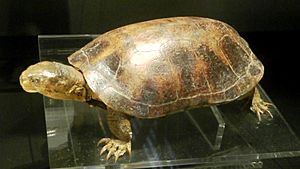Yellow pond turtle facts for kids
The Yellow pond turtle (Mauremys mutica) is a medium-sized turtle. It can grow up to about 19.5 centimeters long. This turtle lives partly in water and partly on land. It has a bright yellow stripe that starts behind its eye and goes down its neck. It belongs to a group of turtles called Geoemydidae.
Quick facts for kids Yellow pond turtle |
|
|---|---|
 |
|
| Specimen of Mauremys mutica kami. It is exhibited in the National Museum of Nature and Science, Tokyo, Japan. | |
| Conservation status | |
| Scientific classification | |
| Genus: |
Mauremys
|
| Species: |
mutica
|
| Synonyms | |
|
|
Contents
Where Yellow Pond Turtles Live
The yellow pond turtle lives in East Asia. You can find it in central Vietnam. It also lives in the coastal areas of southern and central China.
Some groups of these turtles live separately. These groups are found in Taiwan, Hainan, and the Ryūkyū Islands. You can also find them in Japan. Scientists think the turtles in Japan originally came from Taiwan.
Turtle Homes and Food
These turtles like to live in ponds and creeks. They also live in swamps and marshes. They prefer shallow water that moves slowly.
Yellow pond turtles eat many different things. They are omnivores. Their main foods include insects, fish, and tadpoles. They also eat leaves and seeds. During the day, these turtles usually stay in or near the water. They are often more active at night. They tend to go onto land when it rains.
Subspecies and Hybrid Turtles
A subspecies is a group of animals within a species. They are a bit different from others in the same species. Mauremys mutica kami is one subspecies of the yellow pond turtle. It lives in the Ryukyu Islands.
Sometimes, different types of turtles mate. When this happens, they can create hybrid species. These are new turtles that are a mix of two different kinds.
Famous Hybrid Turtles
The Fujian pond turtle (Mauremys iversoni) is a hybrid species. These turtles are mostly created on turtle farms in China. They are born when a female yellow pond turtle mates with a male golden coin turtle (Cuora trifasciata).
Another hybrid species is Clemmys guangxiensis. This turtle is a mix. It comes from a mating between a yellow pond turtle (Mauremys mutica) and a Fujian pond turtle.
Protecting Yellow Pond Turtles
The yellow pond turtle is in danger of extinction. This means there are not many left, and they could disappear forever.
Main Threats to Turtles
One of the biggest threats is the turtle trade in China. People eat a lot of turtles there. This trade harms many Asian turtles, including the yellow pond turtle. These turtles are also used in traditional Chinese medicine.
Some people keep yellow pond turtles as pets. But sometimes, these pets are later killed or abandoned. Water pollution is another problem. It can destroy the places where these turtles live.
What is Being Done
The IUCN is a group that helps protect animals. They say the yellow pond turtle is an endangered species. It is also listed in CITES Appendix II. This means that trading these turtles is controlled to help protect them.
Images for kids



